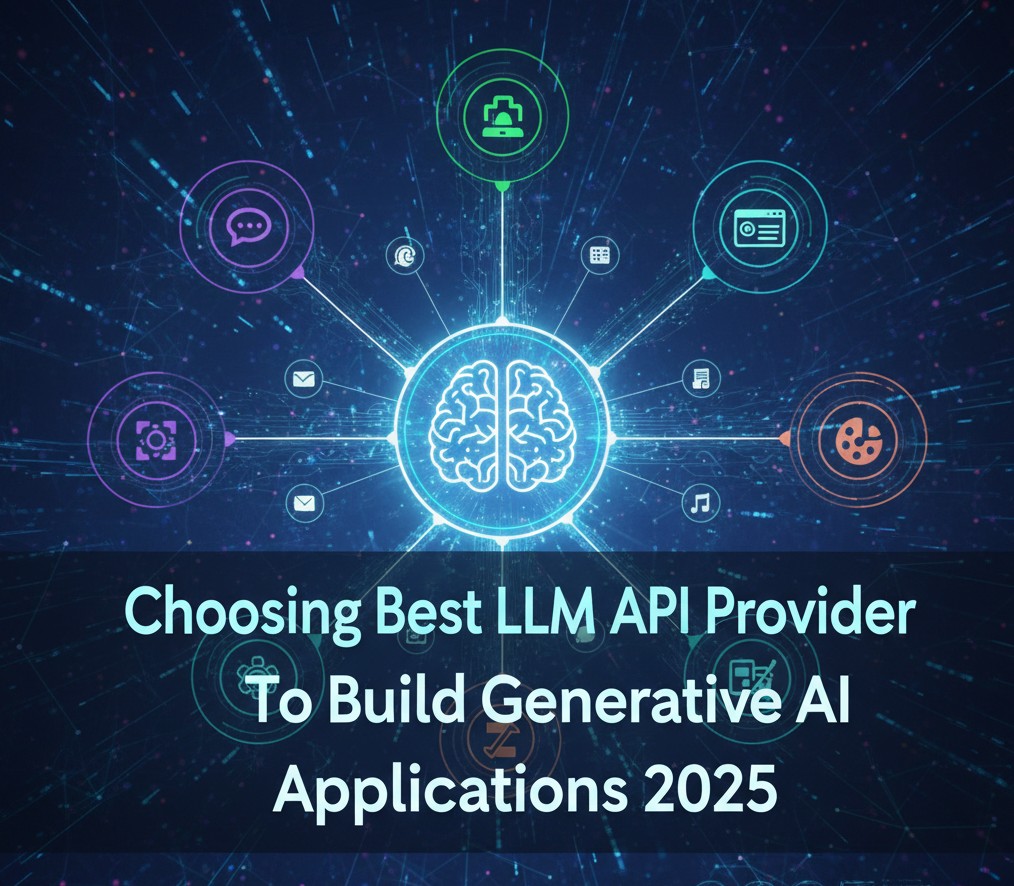
Choosing Best LLM API Provider To Build Generative AI Applications 2025
The Ultimate LLMs API Showdown: Which API Provider is Best for Building Generative AI Applications in October 2025?
2025 is a pivotal moment in AI development. The landscape has shifted dramatically from mere large language models (LLMs) to a highly competitive field dominated by three key trends: truly multimodal AI, the rise of autonomous agents, and a laser focus on enterprise-grade security and compliance.
The question is no longer if you should use an AI API, but which one offers the best combination of power, cost-effectiveness, and ecosystem integration for your specific project.
Here is a breakdown of the leading contenders and a guide to choosing the best API for your application right now.
1. The Cutting-Edge Frontier: OpenAI API
Best for: Builders who need the latest, most powerful models for general-purpose, multimodal, and agentic AI.
OpenAI remains the clear leader in setting the pace for raw model capability. Its October 2025 offerings cement its position for developers chasing state-of-the-art performance.
| Feature Focus | Key Takeaways in Oct 2025 | Why Choose It? |
|---|---|---|
| Model Power | GPT-5 has been released, offering superior reasoning and advanced multimodal AI capable of processing text, images, audio, and video seamlessly. | You need the highest possible accuracy and the ability to process complex, multi-format inputs in a unified system. |
| Agent Development | The release of AgentKit provides a dedicated framework and new Evals (evaluation tools) for building, deploying, and monitoring sophisticated AI agents. | Your application requires autonomous decision-making, tool-use, and multi-step reasoning. |
| Media Generation | Sora 2 is now available via API, offering a cutting-edge generative video model with enhanced realism and control. | Your core feature involves high-quality, long-form video or complex image generation. |
Verdict: Choose OpenAI if your primary concern is leveraging the most powerful, general-purpose intelligence available today, especially for new multimodal or agent-based product features.
2. The Enterprise Titan: Microsoft Azure AI and Google Gemini
Best for: Organizations requiring deep cloud integration, strict security (HIPAA/GDPR), and seamless integration with existing business tools.
For large businesses and enterprises, the choice often comes down to the cloud ecosystem they are already invested in.
Microsoft Azure AI / Azure OpenAI Service
Azure is the AI API choice for organizations heavily invested in the Microsoft stack.
| Feature Focus | Key Takeaways in Oct 2025 | Why Choose It? |
|---|---|---|
| Security & Compliance | Offers Azure’s industry-leading security, private networking, and compliance (HIPAA, SOC 2, etc.) for all OpenAI models (GPT-4/GPT-5). | You are in a highly regulated industry (finance, healthcare, legal) and need enterprise-grade governance. |
| Integration | Copilot Studio 2025 Wave 2 provides a low-code, no-code AI agent builder with multi-agent orchestration, fully integrated with Microsoft 365, Dynamics, and the Power Platform. | Your AI application is a B2E (Business-to-Employee) tool designed to boost productivity within the Microsoft ecosystem. |
Google Cloud AI / Gemini
Gemini’s strength lies in its native multimodal design and deep integration with Google’s search and productivity tools.
| Feature Focus | Key Takeaways in Oct 2025 | Why Choose It? |
|---|---|---|
| Multimodality | Gemini’s models are natively multimodal, meaning they were trained from the ground up to understand text, code, image, and video data, providing a unified AI experience. | Your application relies heavily on real-time data analysis, integrating with Google Workspace, or complex multimodal inputs. |
| Developer Tools | Access to models via Google AI Studio and Vertex AI provides a flexible platform for both rapid prototyping and enterprise-scale ML operations (MLOps). | You need a flexible platform to manage and deploy custom or fine-tuned models within a high-performance cloud environment. |
Verdict: Choose an Enterprise Titan if you need security, compliance, and deep integration with existing software.
- Azure AI: If you live in Microsoft Teams, Office, and Azure.
- Google Gemini: If you live in Google Workspace, use large datasets, and need native multimodal power.
3. The Open-Source & Customization Powerhouse: Hugging Face Inference API
Best for: Startups, budget-conscious teams, and developers who need maximum flexibility, model choice, and cost control.
Hugging Face has evolved into a “GitHub for AI models,” providing an essential infrastructure layer for open-source AI. In 2025, its Inference API and deployment services are a compelling choice for production-grade applications.
| Feature Focus | Key Takeaways in Oct 2025 | Why Choose It? |
|---|---|---|
| Model Choice | Access to over 500,000 community-built models, including top open-source LLMs (like Mistral, Llama, and Falcon families) and specialized models for specific tasks. | You need to use a smaller, specialized model for cost efficiency, or you are explicitly avoiding vendor lock-in with closed-source APIs. |
| Cost & Scalability | The Inference API and dedicated deployment endpoints allow you to serve models with full-stack architecture, providing a production-ready, highly cost-effective alternative to proprietary models, especially for high-volume use cases. | Your application has high-volume traffic, and cost-per-call is a primary concern. Running advanced models is now over 280 times cheaper than in late 2022. |
| Customization | The platform makes it easy to fine-tune models on custom data and deploy them without needing to manage complex GPU infrastructure. | You need a domain-specific AI that must be trained on your unique proprietary data. |
Verdict: Choose Hugging Face if you prioritize customization, cost control, flexibility, and want to leverage the rapid innovation of the open-source AI community.
4. The Specialized Contender: Anthropic Claude API
Best for: Applications where safety, compliance, and very long-context reasoning are non-negotiable (e.g., legal or financial analysis).
Anthropic, founded by former OpenAI leaders, has consistently focused on building “safe, ethical, and effective” AI.
| Feature Focus | Key Takeaways in Oct 2025 | Why Choose It? |
|---|---|---|
| Safety & Reasoning | Claude Sonnet 4.5, launched in October 2025, focuses on regulatory compliance and autonomous coding, excelling in complex reasoning and long-context-window tasks. | Your application deals with sensitive, high-stakes information (e.g., analyzing thousands of pages of legal documents or financial reports). |
| Transparency | Known for offering more transparency in its reasoning, allowing developers to better understand the model’s output. | You need a high degree of explainability and auditability for your AI’s decisions. |
Verdict: Choose Anthropic if your application’s success is tied to processing vast amounts of text securely, safely, and with the utmost rigor in reasoning.
Final Verdict: The Best AI API for October 2025
The “best” API is the one that aligns with your project’s business priorities. There is no single winner, but rather three distinct leaders for different developer needs:
| Project Goal | Recommended API in October 2025 | Key Reason |
|---|---|---|
| Absolute Best Performance / Generative Media | OpenAI API (GPT-5, Sora 2) | Access to the most advanced, unified multimodal and generative models. |
| Enterprise Security & Microsoft Stack | Azure OpenAI Service | Seamless integration with Microsoft 365 and guaranteed enterprise compliance/governance. |
| Maximum Flexibility, Cost Control & Customization | Hugging Face Inference API | Low-cost inference, massive open-source model choice, and production-ready deployment without vendor lock-in. |
| Long-Context Analysis & Safety/Compliance | Anthropic Claude API (Sonnet 4.5) | Superior performance in safe, complex, and reasoning-heavy tasks, ideal for regulated industries. |
Our Recommendation for the General Developer: Start with OpenAI’s GPT-5 for rapid prototyping and feature validation, then evaluate if a more specialized or cost-effective solution like Hugging Face is necessary for scaling to production. If your application targets a major enterprise, build directly on Azure AI or Google Vertex AI from day one.

